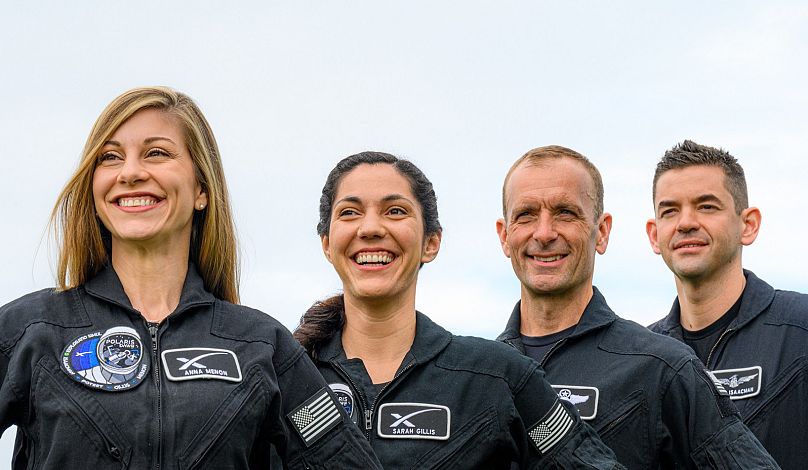A new SpaceX mission will take its crew through a radiation belt to a higher orbit to perform a test spacewalk in new space suits.
After a two-week delay, SpaceX is preparing for its latest launch which will send four astronauts into space to attempt the first private spacewalk.
The Polaris Dawn mission, the first of three missions bought and captained by billionaire Jared Isaacman, will launch from Florida on Tuesday morning with a crew of four: Isaacman, his colleague Scott Poteet, and two SpaceX employees: Anna Menon and Sarah Gillis.
The crew will orbit through a radiation belt and attempt to reach the highest Earth orbit, according to the Polaris Dawn website.
"We stand to learn quite a bit from [this mission] about human health, science and research," Isaacman said in a pre-mission briefing on Monday.
"If we get to Mars one day, we’d love to come back healthy enough to tell people about it".
This mission is also remarkable, according to Isaacman, because it is the first time that a private company will be doing a extravehicular activity (EVA), aka a spacewalk. They plan to do so at roughly 700 km above the Earth.
What is the plan for the mission?
Astronauts will have five days to fit everything into their mission, but most of the focus will be on the spacewalk.
The crew has several times where a potential launch could take place around August 26 and they will pick which time is best to minimise the risk of micrometeorite orbital debris caused by previous missions, according to Isaacman.
On the first day once the crew is in orbit, they will test the Dragon capsule to make sure there are no major faults before they reach 1,400 km orbit.
On that first day, the crew will also pass through the South Atlantic Anomaly, a high radiation zone of the Earth’s magnetic field.
Research done here will look to understand "the effects of spaceflight and space radiation on human health," according to a statement from the Polaris programme.
By day two, the crew will be working on the 40 scientific experiments Polaris Dawn wants to accomplish, Gillis said.
This includes the launch of several SpaceX satellites that can communicate with each other instead of relying on ground infrastructure to send signals.
To do this spacewalk, SpaceX developed a whole new suit called the EVA that has cameras and heads-up displays that show astronauts information about the status of their suits outside their vehicle.
The suits also have what the company calls "improved thermal management" and a helmet that acts like a sun visor.
The third day is the spacewalk where the astronauts will again test the support systems and the suits before the hatch opens and two of the four crew members will complete the walk.
The Crew Dragon vehicle used for the walk has new handholds and a nitrogen repress system that will repressurise the spacecraft once the astronauts are back on the ship.
Isaacman said it will look like the astronauts are "doing a little dance" during their spacewalk, but that it will actually be a way of testing how the suit moves when pressurised with oxygen at such a high altitude.
The walk is supposed to last about two hours and will be live-streamed from Polaris Dawn.
The last two days of the mission will continue with the scientific research that the team is hoping to complete, Gillis added.
Making life 'multiplanetary'
Isaacman said one of the goals of this mission is to bring back scientific data that will work towards SpaceX’s ultimate goal: to make life "multiplanetary".
Elon Musk, SpaceX’s CEO, said as far back as 2008 that multiplanetary life fits on the scale of the world’s major evolutionary stages, like life moving from the oceans to land.
"Going to another planet, you have to go over billions of miles of hostile space… and try to create an ecology on a planet that is nothing like the planet that we live on today," Musk said in a video reshared to his X account in May.
The Polaris Dawn mission will help gather data about the suits that could be needed for "building a base on the Moon and a city of Mars," according to a May statement on the suit launch from the Polaris programme.



















